Enfield Pattern 1851 "Minié" Rifled Percussion Musket
Below is an original trials rifle held in the collection of the Small Arms School at Warminster

By kind permission of the C.O. - S.A.S.C.
Next illustrated is the example described on this page
This is a British Military Enfield Pattern 1851 percussion Minié rifled musket of .702 inch calibre,
with muzzle "tompion" plug and original socket bayonet by Heightington.
Drag horizontally to rotate subject - Click to zoom and drag to pan - Full screen viewing from expansion arrows.
The rifle was made by Thomas Turner of Birmingham (previously of Marlborough), and carries, on the underside of the barrel, the Birmingham Proof House final proof and view marks for the period 1813 -1855. The final proof is the crown over crossed sceptres with "B" to the left "C" to the right, and "P" within the base of the cross. The view mark is the similar crown over crossed sceptres, with a "V" within the base.
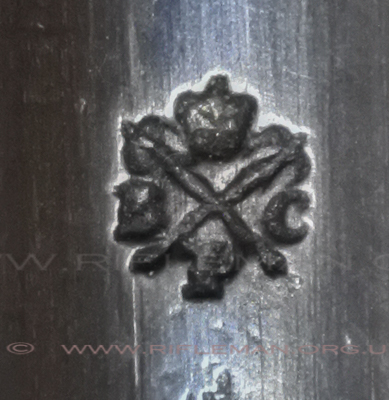 ...........
...........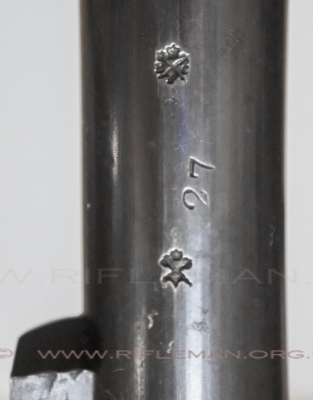 .........
......... 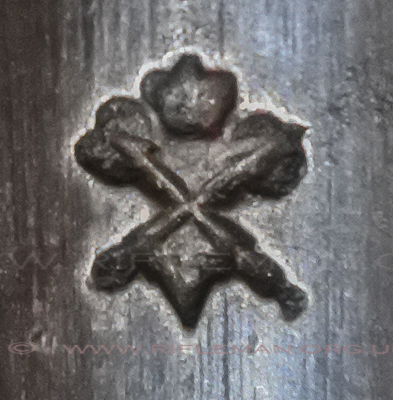
Two inches forward of these marks is the stamping "T. TURNER" and the number "27".
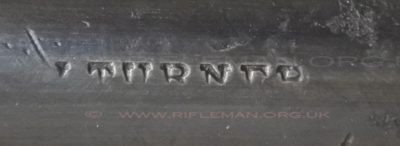
There is a small capital letter "M" stamped immediately behind the rearmost barrel key lug.
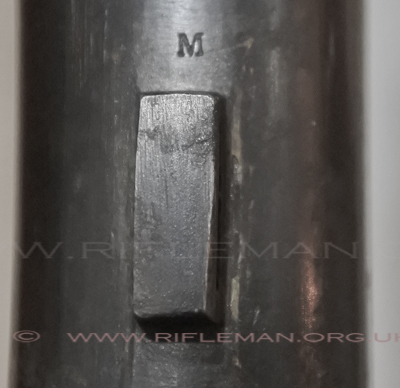
There is also a small letter "L" stamped below the breech plug.
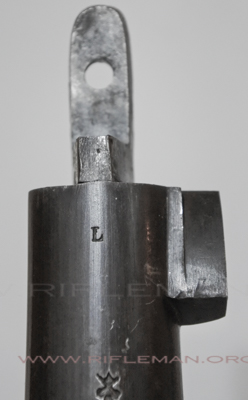
This is a fine original example of the Enfield Tower Pattern 1851 Percussion Minié Rifle.
Ordnance issue rifles usually carry the standard 'TOWER' mark and Royal Cypher but, as can be seen in our rotating and disassembly images, the action plate has no maker or date marks, suggesting the rifle is a commercial, or perhaps Volunteer weapon; but there is another possibility. The only visible mark on the lock is a small number "2" stamped on the rear of the lock plate, and therefore only visible on removal of the lock.
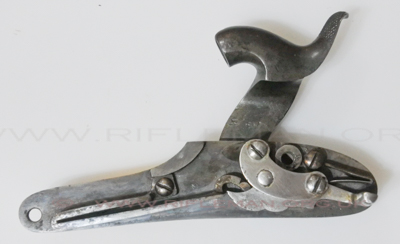 ........
........ 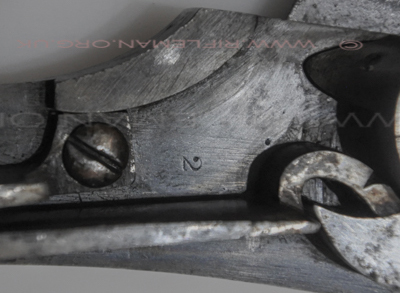
The ram-rod also carries the number "2" stamped just over an inch back from the mushroom end.
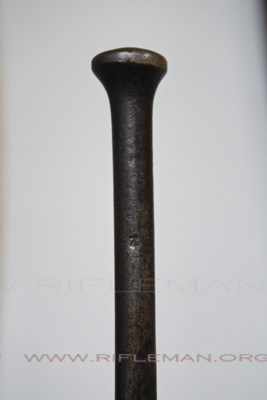
The first five-hundred Minié rifles were completed late in 1852 at the Enfield Royal Ordnance Factory under the supervision of George Lovell, (Enfield 'Storekeeper' during the early 1820s - and inventor of the Lovell bayonet catch used on this rifle), and issued to regiments and depots in Southern England and the Channel Islands each being afforded stands of twenty-five.
At this time, further orders were given to several Birmingham Gunmakers for a total of 23,000 rifles, with Holland & Son and W. Adams to produce 5,000 each, and Hollis & Sheath, Swinburn & Son, Tipping & Lawden and Thomas Turner 3,250 each - at a price per rifle of ca. twenty-three shillings and sixpence. † However, Holland and Adams had agreed prices fourpence and a penny less each respectively, but had upset workers, who demanded wage increases that made the orders unprofitable. Both companies therefore withdrew, leaving the remaining four to complete the orders at 5,750 rifles each at the original price.††
There is an outside possibility that the rifle here illustrated is No.2 of sample or pattern rifles submitted by Turners, it being an early example configured for the modified Pattern 1842 bayonet, as later commercial or volunteer rifles would more likely have been fitted with the follow-on purpose-made bayonet for the 1851 pattern rifle.
These original British socket bayonets for the 1842 Musket, were modified for the 1851 Minié Rifle by dint of the process arranged by Lovell at the Royal Ordnance Factory, in which the larger diameter socket for the 1842 musket was shrunk to the lesser diameter for the later rifle. The bladeof the example on this page is stamped with ordnance inspection mark and is signed by the maker ‘Heightington’. The overall length of the bayonet is 21 ¼”, the triangular blade length is 17 ¼”.
The rifle has all its original woodwork in fine condition, with sling swivels, brass butt plate, trigger guard, stock fittings and fore-end cap together with the expected Lovell’s bayonet catch. It has a block and blade fore sight and adjustable ladder rear sight. The 39” steel barrel’s bore is clean and brigh,t with crisp rifling. The rifle's overall length is 55”. The action is fitted with brass chain and nipple protector and the muzzle has an original period brass capped cork 'tompion' muzzle plug.
The Minié rifle was an important infantry weapon in the mid-19th century (see page 65 and page 64 item 60 of British Military Longarms By Bailey). The Minié rifle was adopted in 1849 following the invention of the Minié ball in 1847 by the French Army captains Claude-Étienne Minié of the Chasseurs d'Orléans and Henri-Gustave Delvigne. The bullet was designed to allow rapid muzzle loading of rifles and was an innovation that brought about the widespread use of the rifle as the main battlefield weapon for individual soldiers. In 1851 the British Enfield factory embarked upon production of the .702” Calibre Pattern 1851 Minié rifle using the conical Minié bullet, which replaced the Pattern 1842 smoothbore musket as the primary weapon issued to regular troops. The Pattern 1851 was referred to as a rifled musket and was longer than previous production rifles, conforming to the length of prior muskets which allowed for consistency in standards for firing in ranks and bayonet combat. Relatively few of these were produced since a new design was adopted within two years. The Pattern 1851 Minié rifle was in use by the British Army from 1851 to 1855. The Minié system was also used extensively by various manufacturers, such as Springfield (the Springfield Model 1861, the most widely used rifle of the American Civil War). These Minié rifles are very rare to find.
The rifle is here shown disassembled, with the Lovell bayonet catch separated
from the front barrel lug, to which it is held with a fine pin when mounted.
The tompion (muzzle plug) is below to the right of the catch.
Click image to bring up hi-res file and magnifier
The four-groove rifling is in fine condition, even at the muzzle's crown.
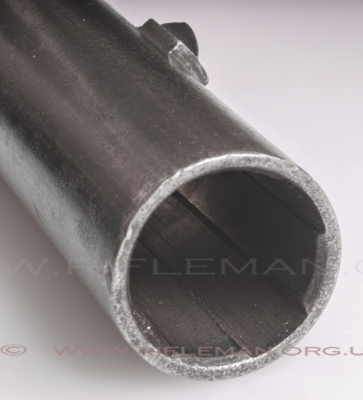
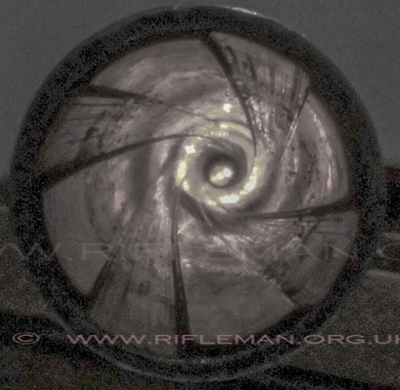 .....
..... 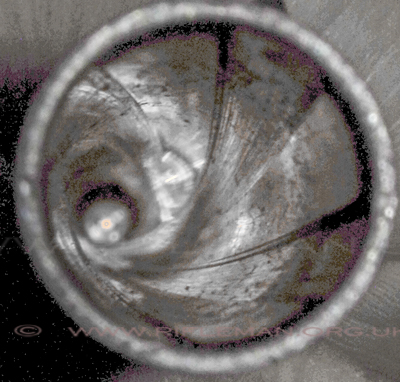
The Minié projectile was the first British service gas-checked bullet that had an iron cup in the base that forced the round to expand fully into the barrel's rifling grooves, providing the greatest range and accuracy of any British service longarm up to that point. The ogived projectile improved significantly on the earlier Baker flintlock rifle, and even on the two-groove Brunswick rifle, each of which require the problematic loading of patched balls. Contemporary critical opinion on both the Brunswick and the Pattern 1842 rifle can be found in the Handbook for Hythe extract further down this page.
The conoidal (but not cylindrical) ogived expanding ( in the rifling) bullet, was still listed by the authorities as "ball" after the earlier spherical projectiles for the muskets. It was invented in 1849 by, and named for, a French army officer named Claude-Etienne Minié, although it was a development of the projectile previously invented by Delvigne
The barrel of these early rifled muskets are held in by sliding keys,
rather than the barrel bands introduced with the later Pattern 1853 rifle.
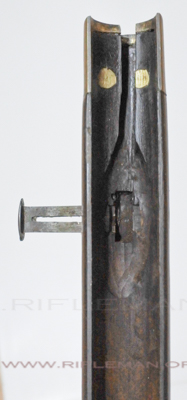 ............
............ 
The cutting-in of the lock is particularly fine, with the sharpest edges
and neatest recessing work that is ever likey to be seen.
It is a credit to the stockers of the day.
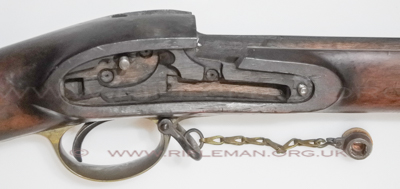
It is interesting that the Turner-made barrel is mounted in a stock that carries the marks of
two makers in the ram-rod groove,
one being one of the four contracted gunmakers for the main Government order.
The two names are shown below, but are difficult to make out.

An infra-red image of the left hand mark shows what appears to be "LAMBERT",
with a preceding character that has yet to be recognised.
Please let us know if you can identify this company or individual.
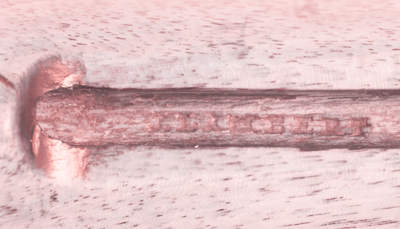
The second, right-hand stamp is quite clearly "HOLLIS & SHEATH"
one of the four companies afforded a contract for 5,7250 rifles.

The folding ladder rear-sight was at the time a particular advance in design for British rifles,
with a 'V' notch at the hinge and a slider to raise it along the inclined base ramp.
The slider also carries a 'v' notch for when the ladder is raised,
and the slide elevates to the ranges marked on the ladder,
which is afforded a final upper notch for the maximum 900 yard range.
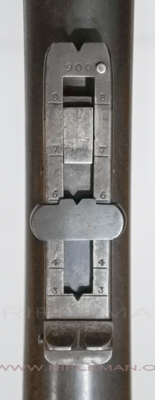 ....................
.................... 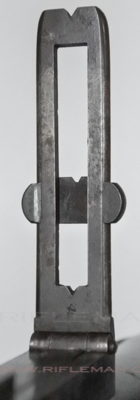
This sight configuration, introduced with the Pattern 1842 rifle,
will be familiar to shooters and collectors of the Martini Henry/Metford/ Enfield rifles.
The rifle with bayonet attached
Click image to bring up hi-res file and magnifier
Below: the socket bayonet by Heightington, with its ordnance inspection mark.
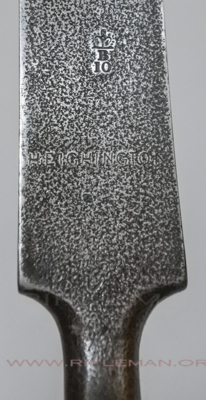
The rifle illustrated on this page was acquired by JC Militaria and passed to us for investigation.
DATA TABLE - ALL MEASUREMENTS AS VIEWED |
||
FIREARM |
IMPERIAL |
METRIC |
| Designation or Type : | Military Pattern Rifle |
- |
| Action Type : | Percussion |
- |
| Nomenclature : | Enfield Pattern 1851 Minié |
with serial no. 2 |
| Calibre : | .702 inch |
- |
| Weight : | lbs. ozs. |
kgs |
| Length - Overall : | inches |
cms |
| Length - Barrel : | inches |
cms |
| Pull : | inches |
cms |
| Furniture : | Walnut |
- |
Rifling - No./Type of Grooves : |
6 - square cut |
- |
| Rifling - Twist : | 1 turn in ? inches - RH |
1 : ? cms |
| Rifling - Groove width : | inches |
mm |
| Rifling - Land width : | inches |
mm |
Rifling - Groove depth at muzzle : |
inches |
mm |
| Sight - Fore : | - |
|
| Sight - Rear : | - |
|
| Sight - Radius : | inches |
cms |
† "British Military Firearms 1650 - 1850" - Howard Blackmore - first published 1961
†† "The British Soldiers Firearm 1850-1864" - C.H. Roads, MA., Ph.D. - first published 1964
Below are five searchable PDF files, being extracts of relevant historical texts
covering the development of the Minié and equivalent rifles and projectiles that expand in the bore.
These are in the form of text-searchable flip-page documents that may take a few moments to load.
Double tap tablet or click ![]() for full page display.
for full page display.
1. TAKEN FROM THE HANDBOOK FOR HYTHE - 1860
The next extract is from a U.S. Army Ordnance Department report on experiments - dated 1867
" FROM REPORT OF EXPERIMENTS WITH SMALL ARMS CARRIED ON AT ENFIELD, (ENGLAND,) 1852,"
The report is of comparative trials of rifles from Messrs. Purdey, Greener, Lovell, Richards, and Wilkinson,
in competition with the then current service Brunswick and issue Minié weapons.
The next extract details the ammunition types at the time,
as well as providing information on the rifles.
From The Textbook of Small Arms - amended to 1868
The Hon. T.F. Fremantle, in his 1860 "Book of the Rifle",
wrote a section which covered the rifles and ammunition contemporary to the subject covered here.
His notes run from the Brunswick rifle to the Whitworth via the Minié, with considerable detail of the ammunition.
The final extract is from the later Textbook of Small Arms of 1909,
and affords an historical reference to the Minié and contemporary rifles ca. 50 years on.
In 1855 the London Illustrated News carried a piece about Monsieur Minié. This is copied here.
M. Minié, INVENTOR OF THE Minié RIFLE.
It is strange that the career of a man whose inventions have revolutionised warfare should have remained, up to the present time, an untold story. Circumstances have afforded the writer an opportunity of communicating to the public an outline of the picture that, at a future time, must show to the world the claims which M. Minié has upon its gratitude. His weapon has borne his name into every quarter of the globe. At this moment it protects the besiegers of Sebastopol ; at this moment it is being copied for the use of the American army ; at this moment a ship is on her voyage to the Crimea with four million Minié cartridges. No impediment has been placed in the way of the general adoption of an invention calculated to serve the allied armies. With unerring aim the French tirailleurs drive the Russians from their guns — thanks to the Minié rifle. We may turn from the Crimean battle-field to the fortress of Vincennes. Passing under the heavy gateways guarded by the celebrated Chasseurs (named after the building) we enter the citadel. Without pausing long to notice the pyramids of cannon baulk ; to examine the hundreds of thousands of muskets in the arsenal ; to remark the marble France weeping over the bones of the Duke d’En«;hein, we turn to a long line of plain buildings on the right, where the ‘ chef du tir’ resides. Here, quietly doing his work, unnoticed, teaching literally ‘ the young idea how to shoot,’ and in his leisure time shut up in his little workshop, lives the ‘ chef de escadron,’ Minié. For fourteen years he has been at Vincennes ; and under his eye those terrible regiments which are now the glory of the French army have been drilled. He began life as a private soldier, having volunteered at an early age. By degrees, under the frown of power often, he has passed the various grades which lie between the private and the ‘ chef d’esca dron.’ His inventions, have, however, brought him his share of mockery, but not half his proper share of honours. Under Louis Phillippe, when the tricolor bade fair to become a pudding-cloth, or at best a pocket-handkerchief for the convenience of an ‘agent de change,’ and when the sentimental felt a strong inclination to turn bayonets into ploughshares, Minié could not hope to find encouragement in high quarters. He began his career by learning with a passionate love of his one idea, all that had been done before him in the matter of arms. He had many, many failures before he achieved a single success. He had to bear up agonist an Artillery Committee composed of Generals who hated changes, and probably enjoyed a notion that it was contrary to the articles of war for a subaltern to exhibit a genius above that of his superior officer. His war with the lovers of routine grew hot ; at last, it reached a climax, and the inventor of the Minié rifle heard that his dismissal from the service of his country had been actually signed. At this critical period of his history M. Minié enjoyed the protection of a man now cast from power, but who was then a prince of the reigning house, and, I believe, resident at Vincennes. I allude to the Duke of Montpensier. To the influence of this Prince, M. Minié owed the withdrawal of his degradation; and at the present time it becomes a duty doubly onerous to acknowledge heartily such a service. This incident does infinite honour to Louis Phillippe’s youngest son. Assured of his position, M. Minié resumed his studies. Established in the fortress of Vincennes, he gave up his time to the shooting gallery and the experiments he loved to make in arms. It was not, however, till the year 1848, that he disclosed improvements of an important nature. From that time up to the present, the improvements he had then effected in rifles, the conical ball, the Minié cartridge, have successively engaged the attention of all enquiring military men. The value of his practical ingenuity was soon appreciated abroad. Offers, some of them very tempting, reached the commandant at Vincennes. Speculators were ready to ensure him fortune; agents were willing to give him tempting terms. He declined every offer. Among the tempters were Russian agents, who offered him the rank of Lieut-Colonel, an establishment, &c, to live in, and a good salary, if he would proceed to St. Petersburg. This offer was made to him two years successively ; and to the honour of M. Minié it should be added that he firmly declined the bargain on both occasions. He declared that he was a soldier and a Frenchman : that he was not a commercial man who followed out his experiments for the sole purpose of realising so much money; but that it was his intention to offer any improvements he might make in arms to his Sovereign. It was his belief that his inventions belonged, by right, to the head of the state. The portrait which accompanies this sketch was taken a few days ago in M. Minié’s atelier, where he was surrounded by all kinds of unfinished arms, heaps of bullets, and bullet-moulds, tools of all kinds, &c. Of the engines of war likely to issue shortly from this atelier, I am, of course, not permitted to speak at length. If his adopted rifle be regarded, however, as a wonderful arm, what will he said of the terrible instrument he is about to present to the Emperor. Holding it in his hand, he pointed to its mechanism, and assured me that he had fired 20 rounds of ball cartridge with it in the course of a single minute. He also showed me the wonderful series of ball he had tried ; they were of every form and weight — conical, circular, with grooves, &c. The ball with which the Imperial Guard is provided is about the size and closely resembles the form of a filbert. He proved the excellence of another (not yet made known) calculated to offer the least possible resistance to the air. The force of the breath through a tube sufficed to lodge it in the wall of the room.
It is just to add that Franco has treated Minié as France treats every man who serves her. The inventor carried one of his rifles to the Emperor; the Emperor’s verdict on the weapon was expressed by a twenty thousand franc note. There was a discussion on the arming of the Imperial Guard; the Emperor sent for the man whose studies best enabled him to give sound advice. Minié went to the Tuilleries. He gave his reason for the adoption of his own arm. These reasons were found to be good ; whereupon the order for his rifles was.at once issued. There was no filtering of powers through endless offices; no delays of artillery committees. The accompanying portrait will show that the inventor of the rifle now in course of adoption in the armies of Europe has been included in the Legion of Honour. The great Stevenson went to his grave an unrecognised man. Minié lives to enjoy the reward of his services — a reward which his country is proud to give him. — B. J.
As a matter of interest we replicate here a fairly comprehensive write-up from the online sale of a similar rifle to that illustrated on this page, sold by College Hill Arsenal, Nashville, U.S.A.
This covers the subject of these rifles from a North American perspective.
The origin of some of the text is otherwise unknown.
At the beginning of the Crimean War, the Pattern 1851 was the most advanced weapon in the British military small arms arsenal. It retained much of the styling of the earlier P1842 musket, with a barrel secured by keys (wedges), and three brass pipes to retain the ramrod. Unlike the .75 caliber P1842, the gun had a slightly smaller bore, measuring .708 and a 39” long barrel that was rifled with four broad, fairly deep grooves of uniform depth. An adjustable long-range rear sight was affixed to the upper rear of the barrel, which was graduated to a maximum distance of 900 yards. The balance of the gun was essentially the same as the earlier pattern smoothbore percussion muskets that it was designed to replace, which themselves were little more than percussion versions of the last of the “Brown Bess” flintlock muskets, the India Pattern or 3rdModel Brown Bess.
The P1851s performed fairly well in the Crimea, particularly when compared to the smoothbore percussion conversion muskets used by most of the Russian conscript army. However, the P1851s were quickly supplanted by the newly adopted Pattern 1853 “Enfield” Rifle Musket. This new gun was a major advance in infantry long arm design and featured a reduced caliber bore of .577, a more advanced rear sight and a barrel secured by clamping barrel bands, instead of the M1851’s wedges. The P1851 was so quickly replaced by the new technology of the “Enfield” that at the conclusion of the Crimean War the guns were considered completely obsolete. The hierarchy of the British military expected long arms to have a useable service life of 10 years and required even obsolete weapons to be held in reserve for emergency issue for at least that long before being offered for sale. However, the Pattern 1851 Minié Rifle was held in such low regard after the adoption of the P1853 that the many of the older guns were “stored” outside, exposed to the weather in an area adjacent to the Tower of London known simply as “the ditch”. More than likely this “storage area” was in fact the old moat that surrounded the Tower in earlier days, and it appears that due to a poorly managed and somewhat corrupt ordnance supply system, much of the surplus materiel from the war in the Crimea suffered a similar fate.
With the coming of the American Civil War, and the urgent need for infantry long arms by both sides, a large number of obsolete British arms were sold as surplus, most of which were sold to the Confederacy by S. Isaac, Campbell & Company. According to Confederate purchasing records, some 14,900 British Pattern 1851 Minié Rifles were purchased during the early days of the war. Most of these arms were purchased between August of 1861 and January of 1862, with a handful purchased in the summer of 1862. Records indicate that at least 10,000 of these arms (and probably all of them) were purchased from J.E. Barnett & Sons of London, who had acquired the guns from the British Ordnance Department. Due to the fact that the arms had been left exposed to the elements in the Tower ditch for several years, Barnett refurbished the guns to make them functional. This apparently included the replacement of worn, damaged or missing parts and also involved re-proving the guns at the London Proof House. Most known examples of Pattern 1851 Minié Rifles that are definitively Confederate imports show a set of London commercial proofs, applied during the Barnett refurbishment process, in addition to their original British military proofs, or their remnants. Barnett sold the majority of these refurbished arms to S. Isaac & Campbell at a rate of 40 shillings each, including the socket bayonet, and the Confederacy was subsequently charged 44 shillings each. The summer of 1862 purchases were sold to the Confederacy at the lower rate of 40 shillings each. The guns were inspected by Messrs. Curtis and Hughes, who had been hired by S. Isaac & Campbell to act as viewers of arms. The P1851s inspected by Curtis & Hughes bear the inspection mark of CH/1 in a small circle, on the upper comb of the stock, forward of the buttplate tang. Confederate documents refer to the Pattern 1851 rifle muskets by a number of different names, including: “Old Army Pattern, rifled”, “Second Hand Government Rifles”, “Minié Rifles”, “Second Hand Rifles 1851 Pattern” , “Brown Bess Rifles 1851 Pattern”and “Rifled Brown Bessies”. Pattern 1851 Rifle Muskets were arriving in Confederate ports no later than January of 1862, with deliveries continuing throughout most of that year. According to the McRae Papers, P1851s were included in the cargos of the blockade runners Gladiator, Harriett Pinckney, Southwick, Stephen Hart and Ella Warley. While the guns that were aboard the Ella Warley and Stephen Hart (some 3,520 guns) were lost to capture by the Federal blockading squadron, 11,380 Pattern 1851 Minié Rifles were successfully delivered to Confederate ports and were subsequently issued for service. These guns had already seen hard use in the Crimea and saw additional hard service in Confederate hands. The end result is that the Pattern 1851 Minié Rifle is now a rarely encountered weapon and to my knowledge, only about a dozen Confederate marked Pattern 1851s are known to exist today.
The British Pattern 1851 Minié Rifle offered here is a very interesting rifle musket. The gun is a commercial gun, not a British military gun, and remains in VERY FINE condition. Due to the extremely short period of use for the guns by the British military, and the fact that the various makers who were contracted to produce them almost immediately turned to manufacturing the Pattern 1853 Enfield for use in the Crimea, commercial examples of these guns are practically unheard of. As the gun was obsolete almost as soon as it went into production, there were likely very few potential commercial buyers for the guns. In fact, other than the British military, the only other major buyer of the Pattern 1851 was the southern Confederacy.
The gun is marked on the lock with the engraved one-line legend: FREDc BARNES & Co LONDON. The firm of Frederick Barnes was initially established in 1825 as a “wholesale gunmaker, percussion cap and accouterment maker”. Their initial location was at 109 Fenchurch Street in London. By 1847 they had added additional locations a 3 Union Row and Tower Hill, in addition to their Fenchurch premises. In 1850, they became Frederick Barnes & Company, dispensed with the Tower Hill location and added a 67 Minories location to their other two locations. In 1856, the firm let the two extra properties go and returned to working from their original Fenchurch Street location only. The company remained in business, through a succession of Barnes’ through the early 20thcentury, closing their doors in 1904. The only other external marks on the gun are a pair of commercial Birmingham proof marks that are present at the breech and the rack or issue number 5 that is stamped on the tang of the butt plate. Under the barrel, the name of the Birmingham barrel maker BEASLEY is stamped, along with the assembly marks 11, 48 and the mating mark \ /. The same “V” style mating marks is found in the ramrod channel (near the nose cap), in the barrel channel (near the breech) and on the top edge of the lock plate.
The metal of the gun’s barrel has a lovely, untouched patina that is a combination of flecked traces of the original blue that has mostly faded and thinned, having turned to a lovely, rich plum brown color. The bottom of the barrel, where the stock has protected it, retains about 90% of the original deep, dark blue. The plum patina on the exterior of the barrel has mixed with some very minor surface oxidation. The metal of the barrel is entirely smooth and free of pitting, with some lightly scattered surface oxidation and some very minute pinpricking here and there. The color case hardened lock has faded and dulled, but still retains some light traces of mottled colors with a mostly smoky gray and silvery appearance with some darker grays, brown and blues here and there. The lock does show some scattered light surface oxidation and some flecks of pinpricking on its surface and retains most of the original vibrant case coloring on its interior. The lock of the gun is mechanically excellent and functions perfectly on all positions. The bore of the gun is in VERY FINE condition. The bore is mostly mirror bright and retains very crisp rifling. The only area of apparent wear present is in one quadrant of the bore about 2 to 3 inches from the muzzle. This may clean out and be old dirt and debris, but it does appear to be some very light pitting. The brass furniture has a very nice, lightly oxidized golden patina that is untouched and remains quite attractive. Unlike most Pattern 1851 Minié Rifles, this gun is 100% complete, correct and original. It retains all three of the original sling swivels. While a standard military P1851 only had two swivels, one in the upper stock above the upper pipe and one on the front of the triggerguard bow, this one also has a toe swivel in the stock, behind the triggerguard tang. The gun also retains its original and complete long-range rear sight (including the delicate ladder and adjustable slide), the original front sight/bayonet lug on top of the barrel near the muzzle and the original Lovell’s Pattern bayonet catch under the barrel. This is another delicate piece that is usually missing when a P1851 is found available for sale. The gun also retains its original and correct ramrod. The rod is full-length and retains good threads on the opposite end. The stock of the musket is in about VERY FINE overall condition as well. The stock is solid and full-length, with no breaks or repairs. The stock remains extremely crisp with very sharp edges with no indication of any sanding. The wood even has traces of the original feathery texture, found only on “as new” condition guns. A thin coat of old varnish is present on the stock that appears to have protected it from the ravages of age. An old collection sticker is present under the stock, in front of the triggerguard that reads: Minié / First Rifled Barrel / 1849. While not entirely accurate, the neat old tag has clearly been on the gun for decades. The only actual condition issue worth noting is a tiny, less than 2-inch long surface grain crack that is present angling up towards the barrel channel on the reverse of the stock, forward of the counterpane. The crack is so unobtrusive and tight that is almost looks like surface scratch rather than a small crack. Otherwise, the stock does show a number of scattered minor bumps, dings and mars from handling use during its service life but shows no abuse. The musket appears to have seen some light real-world use but was never abused or mishandled.
Overall this is a really wonderfully complete, very high condition, 100% correct and original example of a very scarce Pattern 1851 Minié Rifle. This only the second commercial example of a Pattern 1851 that I have ever encountered, and this makes me think that it may have been made up from old parts to be sold to the speculative Confederate buyers in 1861 and 1862, and then subsequently captured. As not all of the P1851s were delivered through Barnett and Sinclair, Hamilton & Co, it would be reasonable to assume that not all of the CS purchases received the CH/1inspection mark. It is quite possible that the gun was a speculative purchase, rather than a government purchase, which would not have received any form of inspection marks. The gun remains extremely crisp, despite showing some light real world use and is very attractive. From a condition standpoint, this is one of the finest examples of a Pattern 1851 Minié Rifle I have ever seen, let along had the opportunity to offer for sale. All P1851s are quite scarce, and this one is a wonderful example that will be a fine addition to any collection of 19th. Century English arms or a representative example of a pattern that was imported by the Confederacy in some quantity during the war.



